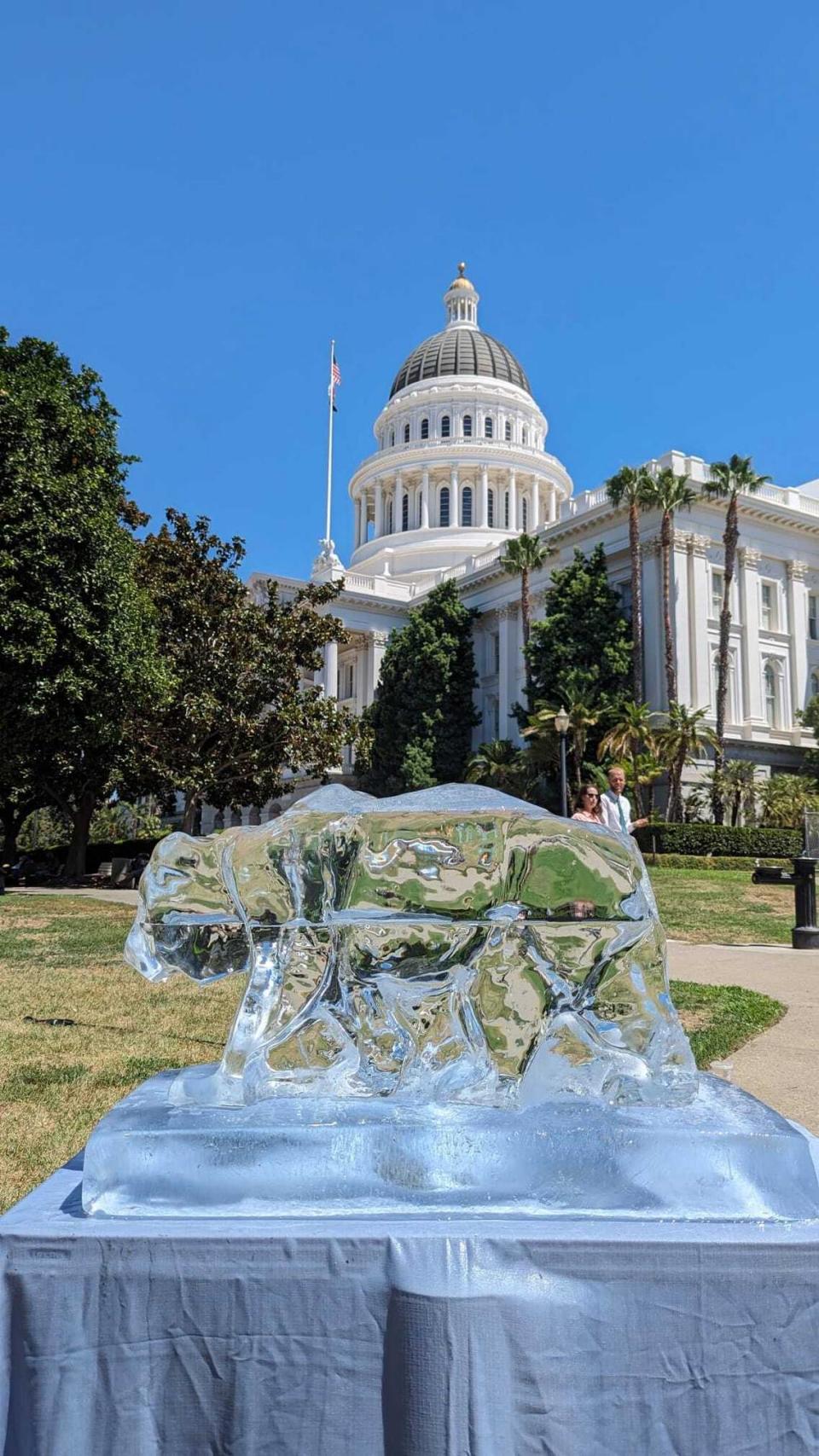California lawmakers push to cut fossil fuels, greenhouse gases from millions of buildings
Amid Thursday’s scorching heat, California lawmakers campaigned for a suite of bills they hope will tackle one of the state’s largest but overlooked sources of carbon pollution causing global warming: buildings.
State agencies have adopted several policies encouraging all-electric new construction. Nevertheless, the push to cut fossil fuels and the greenhouse gases they emit from the state’s millions of existing buildings has made little headway.
Next to a quickly melting ice sculpture of a California bear and a heat pump, which cools and warm homes more efficiently, lawmakers and advocates said their measures will help accelerate the transition from gas-powered buildings.
“California’s leading the way on clean energy on transportation. Now we’ve got to lead the way on clean, electric buildings,” said Laura Deehan, state director for Environment California. “We want to tackle climate pollution every day in people’s homes, in community buildings, in schools, in businesses and the big, big buildings all across the state.”

The group of bills dubbed ‘Upgrade California’ would establish emission standards for the state’s large commercial buildings, connect clean appliances to the electrical grid faster and initiate master plans for decarbonizing homes and schools.
California has cut emissions from its transportation sector and in-state electricity generation by well over 20% in the last two decades. Yet pollution from residential buildings has remained mostly stagnant and increased by 51% in commercial buildings.
One likely reason is the millions of dollars spent by utilities against the local and statewide push for building electrification. A Sacramento Bee investigation found that some of SoCalGas’ political opposition to climate policies has been billed to ratepayers.
Utilities are prohibited from spending ratepayer dollars on political activities, but the practice is difficult to catch and widespread, found The Bee and the watchdog arm of the California Public Utilities Commission.
States including Colorado, Connecticut and Maine have recently passed legislation that would prevent utilities from billing ratepayers for political lobbying.
Asked about potential responses in the California legislature, Sen. Josh Becker of San Mateo said “I think it’s clear that we’d like to do something.”
Becker, who represents the San Francisco Peninsula, authored two bills this year meant to hasten building electrification and help meet state climate goals. After Gov. Gavin Newsom passed a larger package of clean energy measures last year, advocates say fewer climate bills have made it to the end of this legislative session.
“We just have not made that much progress,” Becker said. “We have to think about how we’re going to attack those millions of existing structures. This legislative package is meant to put that front and center.”
One measure, SB48, would regulate energy efficiency and carbon emissions for commercial buildings larger than 50,000 square feet, a bill inspired by similar laws in Colorado and Washington. Another would speed up the time it takes for homes and other buildings to connect their clean energy to the electricity grid, SB410.
Two additional bills in the package would require the California Energy Commission to develop a comprehensive strategy to decarbonize all existing buildings in the state, AB593, and form a master plan to make public schools climate resilient, SB394.
Assemblyman Matt Haney of San Francisco, who authored AB-593, said a detailed plan will help building owners switch to all-electric appliances in pursuit of state climate goals, which have been criticized for lacking actionable implementation strategies.
“We have to actually say, here’s how we’re going to support Californians,” Haney said. “Here’s how we’re going to train the workforce to make that transition to clean air conditioning, heat pumps, and clean energy technology.”
The state’s leading climate agency, the California Air Resources Board, has indicated that meeting its 2030 goal to reduce statewide greenhouse gas emissions 40% below 1990 levels faces serious obstacles.
The air board’s overarching climate plan assumes that 80% of new heating, ventilation, and air conditioning and water heater sales in the state will be electric by 2030, in both residential and commercial buildings.
After passing several policies to promote clean energy in new buildings, state agencies are beginning to tackle the intimidating task of converting existing homes, businesses, offices and other buildings across California.
Last year, the board adopted a strategy to end the sales of gas-powered space and water heaters starting in 2030, and the California Energy Commission adopted building energy efficiency standards that encourage electric heat pump and solar technology.
Earlier this year, the California Public Utilities Commission also decided to reduce incentives for gas in new construction.
Now the air board is assessing whether buildings can meet those targets, and is considering a regulation that would ban the sale of all new gas appliances starting in 2030. The rule would allow only the sale of zero-emission appliances.

